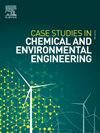Solvothermal synthesis of α-MnO2 and Mn2O3 for efficient catalytic dye degradation
Q1 Environmental Science
Case Studies in Chemical and Environmental Engineering
Pub Date : 2025-05-23
DOI:10.1016/j.cscee.2025.101242
引用次数: 0
Abstract
The increasing industrial demand for synthetic dyes, particularly in textiles as well as pulp and paper sectors, is a significant factor that intensified environmental pollution due to dye-contaminated wastewater. Therefore, this study aimed to develop efficient manganese oxide-based catalysts for methylene blue (MB) degradation through a one-step solvothermal synthesis route. Phase evolution of the synthesized MnO2 materials was primarily governed by heating temperature and duration, rather than pH adjustment. Samples A-8 and A-9 of Mn2O3 were synthesized at 140 °C for 24 h, while A-10 and A-11 of α-MnO2 were synthesized at 105 °C for 6 h. The results of morphological analysis showed that A-8 had rod-like structures, while A-9 contained a hierarchical architecture comprising rods and cubes. Acid-treated samples (A-8 and A-11) had higher crystallinity than A-9 and A-10 synthesized under alkaline conditions. The catalytic performance in MB degradation correlated with the presence of Mn3+/Mn2+ redox pairs and oxygen vacancies, where A-9 presented superior stability across a broad pH range of 1–11. Furthermore, acidic conditions significantly enhanced degradation efficiency compared to systems applying H2O2. Fragmentation of MB into simpler molecules confirmed the proposed degradation mechanism. The best performance was achieved using A-9 under 200 mg L-1 MB, pH 1, 0.007 g L-1 catalyst, and 30 min reaction time, signifying the potential for practical dye wastewater treatment applications.
溶剂热合成α-MnO2和Mn2O3高效催化降解染料
工业对合成染料的需求日益增加,特别是在纺织以及纸浆和造纸部门,这是由于染料污染废水而加剧环境污染的一个重要因素。因此,本研究旨在通过一步溶剂热合成的方法开发高效的氧化锰基亚甲基蓝(MB)降解催化剂。合成的二氧化锰材料的相演化主要受加热温度和持续时间的影响,而不受pH调节的影响。样品8和9 Mn2O3合成在140°C 24 h,而a - 10和11α的汇总合成在105°C 6 h。形态分析的结果表明,8棒状结构,而9包含一个分层架构组成的棒和多维数据集。酸处理后的样品(A-8和A-11)结晶度高于碱性条件下合成的A-9和A-10。催化降解MB的性能与Mn3+/Mn2+氧化还原对和氧空位的存在有关,其中a -9在1-11的广泛pH范围内表现出优异的稳定性。此外,与使用H2O2的系统相比,酸性条件显著提高了降解效率。MB分裂成更简单的分子证实了所提出的降解机制。在200 mg L-1 MB、pH为1、0.007 g L-1催化剂、反应时间为30 min的条件下,A-9的性能最佳,具有实际染料废水处理的潜力。
本文章由计算机程序翻译,如有差异,请以英文原文为准。
求助全文
约1分钟内获得全文
求助全文
来源期刊

Case Studies in Chemical and Environmental Engineering
Engineering-Engineering (miscellaneous)
CiteScore
9.20
自引率
0.00%
发文量
103
审稿时长
40 days
 求助内容:
求助内容: 应助结果提醒方式:
应助结果提醒方式:


